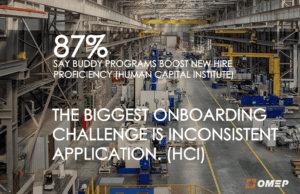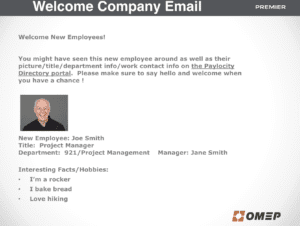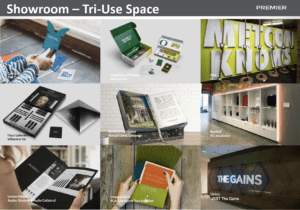 Why are 44 percent percent of manufacturing employees quitting within their first year on the job?
Why are 44 percent percent of manufacturing employees quitting within their first year on the job?
Manufacturers who are finally able to get workers in the front door are leaving the backdoor wide open through inconsistent or poor new hire onboarding experiences. Eighty-eight percent of organizations openly admit they don’t onboard well, yet we know that employees who had a negative onboarding experience are twice as likely to seek new job opportunities in the near future.
ONBOARDING INFLUENCE RUNS DEEPER THAN NEW HIRE PERCEPTIONS
Broken or underutilized onboarding systems are a huge hit to the bottom line, especially for a small business. Not only are there soft costs that are lost such as decreased productivity, low morale, and lack of time for leaders to focus on strategy, but also hard costs such as candidate search fees and loss of customers due to the inability to provide services/products.
WHAT DOES SUCCESSFUL ONBOARDING LOOK LIKE?
How can you create a lasting positive impression that will enrich the lives of your new hires and keep your existing employees engaged? The answer (and the biggest challenge) for Oregon’s small and mid-sized manufacturing companies is the consistent application of new hire onboarding best practices. In this article, we will explore a few of the tools and techniques small and mid-sized manufacturers are using to build solid onboarding programs.
There is no silver bullet for workforce challenges and beefing up a lagging onboarding program takes time and dedication. You can’t expect to see results after one go-around. However, filling in the gaps in your onboarding program will allow you to stem the tide of new hires leaving and begin to see positive results.
PREPARE EFFECTIVELY
 It took time to find, interview and hire your candidate. The preparation is not over now that they are hired. In fact, it has only just begun. Many small manufacturers have one HR manager or admin who manages a wide variety of duties, including onboarding. We hear from clients regularly that they are overwhelmed trying to onboard new employees. By establishing simple repeatable systems, and engaging others in the onboarding process, this person can manage new hire onboarding more efficiently and consistently every time.
It took time to find, interview and hire your candidate. The preparation is not over now that they are hired. In fact, it has only just begun. Many small manufacturers have one HR manager or admin who manages a wide variety of duties, including onboarding. We hear from clients regularly that they are overwhelmed trying to onboard new employees. By establishing simple repeatable systems, and engaging others in the onboarding process, this person can manage new hire onboarding more efficiently and consistently every time.
Create an onboarding checklist and a schedule for the employee’s first day, showcasing when, where, and who they will be partnering with through the process. Print and share that schedule with everyone involved. Work with the new hire’s manager to create a clear 30-60-90 day program for that new employee so that expectations are clear. Build an employee onboarding toolkit for the first months of employment so everyone has a roadmap to fully understand expectations.
Prepare training materials with the new hire’s manager so they are ready to begin. Consider using a cloud-based tool or learning management system to more easily deploy, track, document, and manage training across the organization.
CREATE A WELCOMING ENVIRONMENT
Begin by announcing the new hire to all existing employees. Premier Press, a print manufacturer, sends an email to all staff letting them know who the new hire is. In that email they share the person’s picture, inviting employees to welcome that person, and give a few interesting facts about the new hire to spark conversations.
Another best practice is to send the candidate a letter as well, welcoming them to the team, and explaining the basics of working at your company. What are the intangible or unwritten rules that would be helpful to know? Where should they park on their first day? What entrance do they use? What is the company’s dress code? Should they bring their own lunch on the first day, or will some of the staff be taking them out to lunch? Take the anxiety out of the process for a new employee, so they can focus on their new role and absorb information.
CRAFT AN INTENTIONAL FIRST DAY FOR NEW HIRES
On the first day that the new hire is on-site, leadership has an opportunity to create a consistent experience that will set the tone for the rest of that person’s employment. All manufacturers can showcase not only the products they make but why they are important to the end-user. Helping new hires connect their daily work to larger organizational goals is a key tenant of continuous improvement principles and will empower that employee to connect their role to a wider purpose. This increases engagement boosts productivity and begins the process of employee empowerment. Such spaces can also serve as customer showrooms and meeting spaces.
employment. All manufacturers can showcase not only the products they make but why they are important to the end-user. Helping new hires connect their daily work to larger organizational goals is a key tenant of continuous improvement principles and will empower that employee to connect their role to a wider purpose. This increases engagement boosts productivity and begins the process of employee empowerment. Such spaces can also serve as customer showrooms and meeting spaces.
Premier Press has a ‘showroom’ where they walk employees through several of their products, and talk through the organization’s mission, vision, values, and shared KPIs. Even if you don’t have space for a full showroom, setting aside an area to display products should be possible. The key here is not just showcasing products, but making the connection that the employee is a key deliverer of wider organizational goals and objectives.
Hear Premier Press discuss onboarding strategies in our recent webinar here >
CREATE A SENSE OF BELONGING AND EMPOWERMENT
While the new hire is on-site, manufacturers can spend their day building connections with existing employees. Assign them a buddy or mentor for the first few months. Take them to lunch and introduce them to their team. Have employees walk the new hire around and show them where to get supplies, introduce them to people throughout the organization. With the manager, talk through the new hire’s 30-60-90 day plan to set clear and measurable expectations.
ONBOARDING AS A TOOL
Ultimately, a good onboarding experience introduces a new employee to their team, connects them to a larger sense of purpose, builds an emotional connection, and sets clear and measurable expectations for that employee. There is no silver bullet for workforce challenges but implementing onboarding best practices with continuous improvement principles in mind is key to employee engagement and successfully bringing new employees up to speed quickly.



